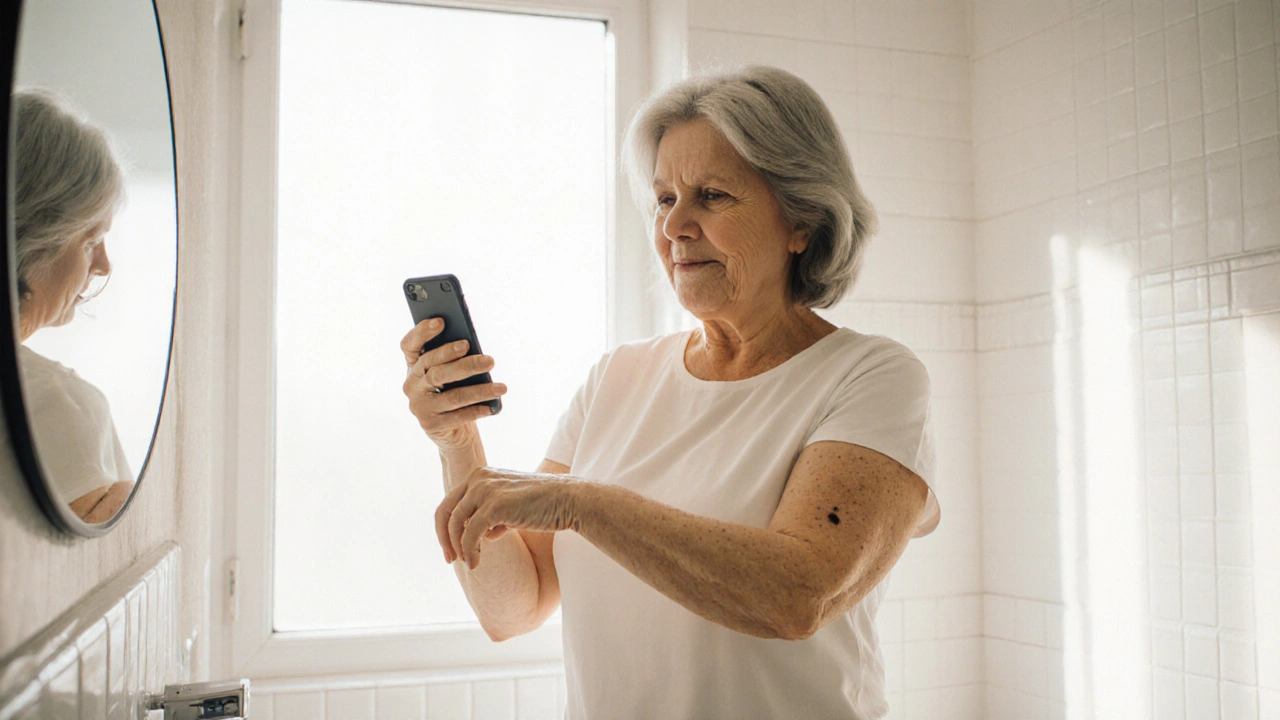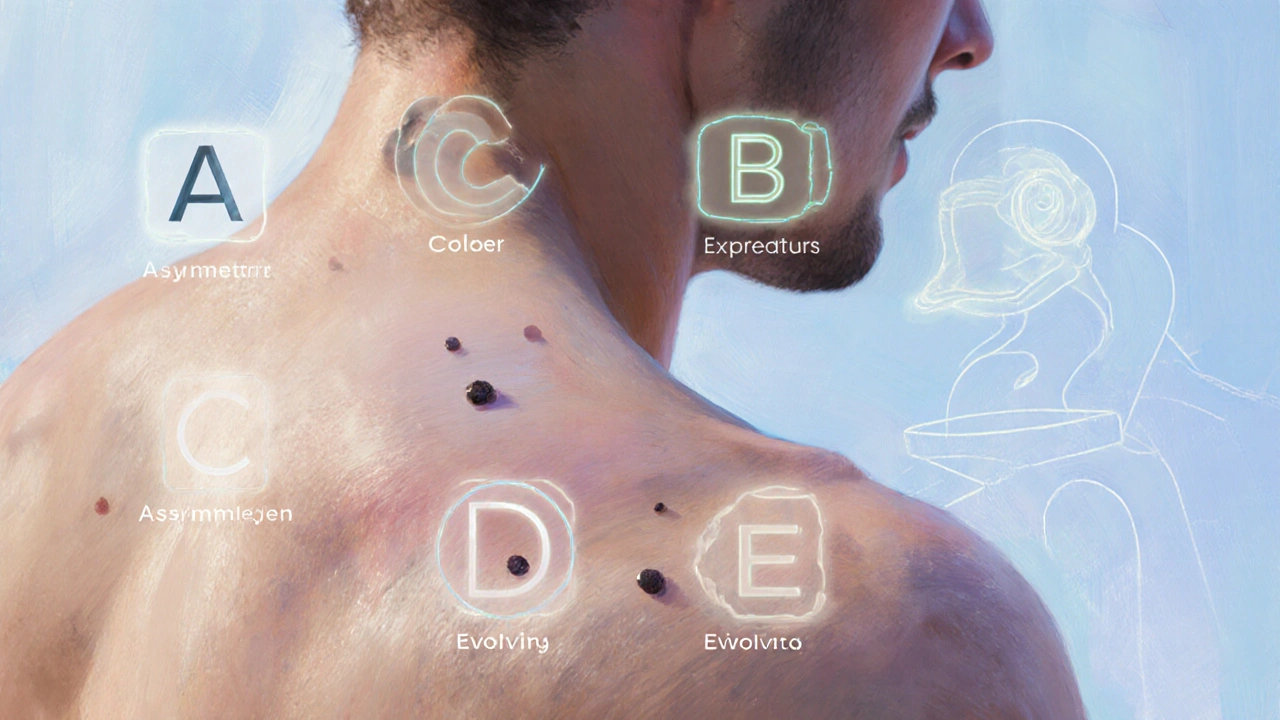Melanoma Self-Exam: Step-by-Step Guide to Spotting Skin Cancer Early
 Sep, 28 2025
Sep, 28 2025
When you glance at your skin, melanoma is a serious form of skin cancer that starts in the pigment‑producing cells called melanocytes. Catching it early can mean the difference between a simple excision and a life‑threatening battle. That’s why a regular melanoma self exam is worth a few minutes each month.
Quick Takeaways
- Do the exam once a month, preferably after a shower.
- Use a full‑length mirror and a handheld mirror for hard‑to‑see spots.
- Apply the ABCDE rule and the Ugly Duckling method to each mole.
- Document any changes with photos or a skin‑tracking app.
- See a dermatologist promptly if anything looks odd.
Why a Self‑Exam Matters
Skin cancer is the most common cancer worldwide, and melanoma accounts for the majority of skin‑cancer deaths despite being only about 1% of cases. Early detection boosts the five‑year survival rate to over 98% for localized disease. Since most melanomas develop from existing moles, knowing what’s normal on your own body is the fastest way to spot a problem.
When to Perform the Exam
The best time is after a warm shower or bath-your skin is clean and the pores are open, making lesions easier to see. Mark your calendar for the same date each month; consistency helps you notice subtle changes.
Gather Your Tools
- Full‑length mirror (standing height)
- Handheld mirror for the back, scalp, and between toes
- Good lighting-natural daylight or a bright LED lamp
- Pen and notebook or a skin‑tracking app for notes and photos
Step‑by‑Step Self‑Exam
- Set the stage: Stand in front of the full‑length mirror, turn on bright lighting, and have your handheld mirror ready.
- Inspect the front: Look at your face, neck, ears, chest, and arms. Use the handheld mirror to check the sides of your neck and the back of your ears.
- Check the back and torso: Lean forward, using the handheld mirror to view your back, buttocks, and lower spine.
- Examine the legs and feet: Sit or stand and use the handheld mirror to see the tops of your feet, the soles, and between the toes.
- Don’t forget the scalp: If you have short hair, run your fingers over the scalp and use the handheld mirror to spot any lesions. For longer hair, part it and inspect the exposed skin.
- Apply the ABCDE rule to every mole you see. ABCDE rule is a mnemonic for Asymmetry, Border, Color, Diameter, and Evolution. Look for:
- Asymmetry: One half doesn’t match the other.
- Border: Uneven, scalloped, or blurred edges.
- Color: Multiple shades-brown, black, red, white, or blue.
- Diameter: Larger than 6mm (about the size of a pencil eraser).
- Evolution: Any change in size, shape, color, or symptoms like itching or bleeding.
If a mole fails any of these checks, it warrants a closer look.
- Use the Ugly Duckling method: Compare each mole to the others on your body. A mole that looks different from the rest-odd shape, unusual color, or sits in a spot where you have none-should be flagged.
- Record your findings: Take a photo of any suspicious spot, note the date, and describe what you see using the ABCDE criteria.
- Take action: If something looks off, don’t wait. Schedule an appointment with a dermatologist who specializes in skin conditions and can perform a biopsy if needed.
Understanding Risk Factors
Knowing what puts you at higher risk helps you stay vigilant. Key risk factors include fair skin, extensive sun exposure, a family history of melanoma, and a large number of moles. If you fall into any of these categories, consider performing the exam two times a month.

Sun Exposure and UV Index
UV radiation damages DNA in skin cells, increasing melanoma risk. Check the daily UV index on weather apps; a rating of 6 or higher calls for sunscreen SPF30+ and protective clothing.
Common Pitfalls and How to Avoid Them
- Poor lighting: Dim light hides color variations. Use daylight or a bright lamp.
- Skipping hard‑to‑reach areas: Back, scalp, and foot soles are common sites for missed lesions.
- Relying only on size: Small lesions can be dangerous if other ABCDE signs are present.
- Ignoring evolution: Even a tiny mole that changes rapidly is a red flag.
Comparison: ABCDE Rule vs. Ugly Duckling Method
| Aspect | ABCDE Rule | Ugly Duckling Method |
|---|---|---|
| Focus | Specific characteristics of each mole | Comparison of a mole to an individual’s overall mole pattern |
| Strength | Clear, clinical criteria | Highlights outliers that may be missed by ABCDE alone |
| Weakness | Can overlook subtle changes if size < 6mm | Subjective; depends on how many moles you have to compare |
| Best use | First‑line screening for anyone | Additional check for people with many moles or atypical mole patterns |
Next Steps After Finding a Suspicious Spot
- Don’t panic-most changes are benign.
- Schedule a dermatologist visit within two weeks.
- Bring your photos and notes; they help the doctor decide whether a biopsy is needed.
- Follow any recommended treatment plan promptly.
- Update your self‑exam records and keep monitoring other moles.
Pro Tips for an Effective Exam
- Use a magnifying glass for the scalp and areas with many fine hairs.
- Consider a skin‑tracking app that lets you overlay old photos for direct comparison.
- Ask a partner to help you feel for raised lesions on hard‑to‑see spots.
- Stay consistent with lighting-natural daylight reduces color distortion.
Frequently Asked Questions
How often should I do a melanoma self‑exam?
Aim for once a month, ideally after a shower. If you have high risk factors-fair skin, many moles, family history-twice a month is advisable.
Can I rely on a smartphone camera for the exam?
Smartphone cameras are fine for documentation, but they shouldn’t replace a professional examination. Use them to track changes and show the dermatologist.
What does ‘E’ in the ABCDE rule stand for?
‘E’ stands for Evolution-any change in size, shape, color, or new symptoms such as itching or bleeding.
Is a mole that’s exactly 6mm always dangerous?
Size alone isn’t decisive. A 6mm mole without other ABCDE warning signs can be benign, but any evolution or asymmetry still warrants a check.
When should I see a dermatologist after spotting a change?
Schedule an appointment within two weeks of noticing a new or changing lesion. Faster evaluation improves treatment outcomes.

Diana Sabillon
September 28, 2025 AT 23:14I did my first self-exam last month after reading this and found a weird spot on my back I’d ignored for years. Turns out it’s just a benign mole, but I’m so glad I checked. This guide literally saved me from anxiety for weeks.
neville grimshaw
September 30, 2025 AT 01:47Oh for fuck’s sake, another ‘check your moles’ article. I’ve got 47 of them, I’m not playing mole bingo every month. 🤡
Also, ‘ugly duckling’? That’s the dumbest metaphor since ‘the sun is a big yellow ball’. I’m out.
bert wallace
September 30, 2025 AT 21:38Neve, you’re being dramatic, but I get it. Doing this every month is a chore. But here’s the thing: melanoma doesn’t care if you’re lazy or pretentious. I had a buddy who skipped checks for 5 years. He’s in chemo now. This isn’t about being a good citizen-it’s about not dying stupidly.
Do it once a month. Set a reminder. Use an app. Five minutes. Your future self will thank you.
Neal Shaw
October 1, 2025 AT 15:25For clarity: the ‘E’ in ABCDE stands for Evolution-not just size or color change, but any alteration in symptoms like itching, bleeding, or crusting. Many people miss this because they’re fixated on the visual. Evolution is the most predictive indicator of malignancy.
Also, the Ugly Duckling method is empirically validated in dermatology literature as complementary to ABCDE, especially in patients with >50 nevi. It’s not a metaphor-it’s a clinical heuristic.
And yes, smartphone photos are fine for tracking, but only if they’re taken under consistent lighting and distance. Use a ruler next to the mole for scale.
Philip Crider
October 3, 2025 AT 06:24Look, I’m not a doctor, but I’ve stared at my own skin like it’s a cosmic riddle since my cousin died of melanoma at 29. 🕯️
It’s not about fear-it’s about paying attention to the body that carries you. You don’t need to be perfect. Just show up. Take a pic. Notice the weird one that doesn’t fit. That’s all.
And yeah, I typoed ‘moles’ as ‘molees’ three times in this comment. I’m tired. But I did my exam today. So should you.
Love y’all. Stay alive.